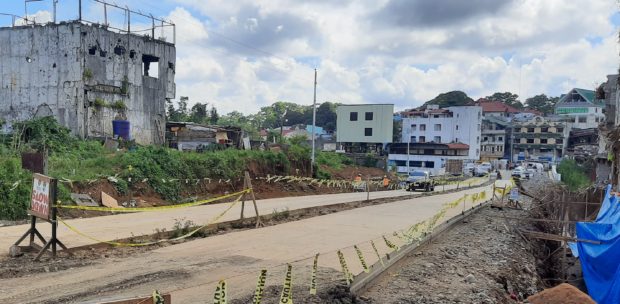
RECONSTRUCTION | A major road leading to the heavily damaged city center of Marawi, the main battleground during the 2017 siege, is among the first to be reconstructed in the government-led rehabilitation of the Lanao del Sur provincial capital. (File photo by RICHEL V. UMEL / Inquirer Mindanao)
Leaders of residents displaced by the Marawi City siege in 2017 and groups supporting them lauded the signing by President Rodrigo Duterte of the Marawi compensation law, saying this would help hasten the rehabilitation and economic recovery of the Lanao del Sur provincial capital.
Fedelinda Tawagon, president of Dansalan College and a member of the Marawi Reconstruction Conflict Watch (MRCW), said the law would help “rekindle our hope for a better future.”
Communications Secretary and acting presidential spokesperson Martin Andanar announced on Wednesday that the President had signed Republic Act No. 11696, which provides compensation to people whose properties were destroyed and who lost their loved ones during the five-month siege by Islamic State-linked militants five years ago.
Also entitled to receive compensation were those whose properties were demolished during the implementation of the Marawi Recovery, Rehabilitation and Reconstruction Program, including the search for and recovery of unexploded ordnance.
Justice, equal priority
Andanar said Mr. Duterte signed the measure on April 13, two days before it would have lapsed into law.
According to Saripada Pacasum Jr., convener of Lanao del Sur Early Response Network, the law is expected to “jumpstart recovery of the people of Marawi.”
“With the President’s signing of this law, he delivered justice and equal priority to the Maranaos who have lost and sacrificed so much in the past five years,” Pacasum said.
MRCW member Jalilah Sapiin said the compensation would provide the financial means for displaced families to recover from the devastation brought by the war in 2017.
A government profiling in 2018 counted more than 15,000 families who were displaced from 24 villages in the city center that comprise what is now called the “most affected area” (MAA) of the battles. Of them, less than 3,000 had applied for building permits and only a few hundred were able to actually build their houses.
Under the new law, compensation will be for properties in the MAA, comprising 24 villages, and eight villages classified as “other affected areas.”
The fair market value of land and lost personal properties and the replacement cost of destroyed structures are the general bases for providing compensation, which will be tax-free.
National budget
A Marawi Compensation Board had to be organized to oversee the process. The funds for compensation will come from the annual budget of the national government.
“When we started the struggle and fight for the rights of Marawi siege victims and survivors, it was an uphill climb all the way. We never even thought we would witness this day come. But we did,” recalled Dr. Rolanisah Dipatuan-Dimaporo, another MRCW member.
Tawagon described the law as “a moral and legal victory for the Meranaw IDPs whose lives have been suspended in the long process of rehabilitation and recovery of Marawi City and its people.”
—WITH REPORTS FROM BONG SARMIENTO AND NESTOR CORRALES
RELATED STORIES
Duterte signs law compensating Marawi Siege victims
Gov’t sets turnover of 400 houses in Marawi
Robredo vows to get funding for Marawi compensation bill